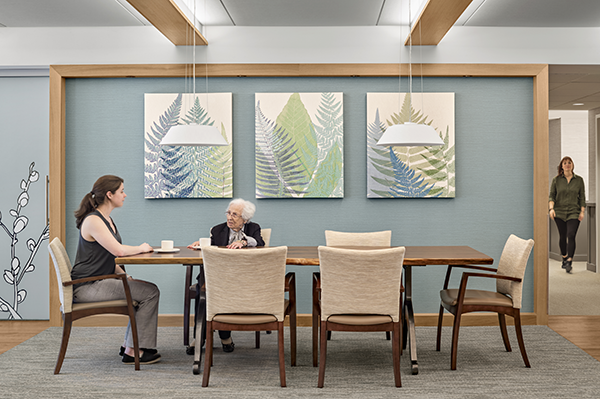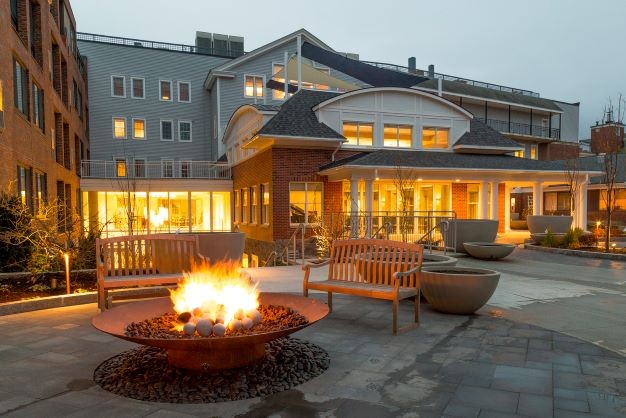- Who We Are
-
Our Work
-
Educational
- Brooks School- George and Evanthea Demoulas Family Boathouse
- Riverbend School - Gym and Schoolhouse
- Lesley University- Animation Studio
- Middlesex School- Bass Arts Pavilion and Danoff Visual Arts Center
- Nashoba Brooks School- Sureau Family Discovery Barn
- The Southport School- Arts and Music Building
- Senior Living
- Hospitality
-
Healthcare
- Partners Urgent Care
- Yale New Haven Health- Medical Office Building
- The Hospital of Central Connecticut - Advanced Wound and Hyperbaric Medicine Center
- Connecticut Children's - Infusion Center and Gastrointestinal Clinic
- Connecticut Children's - Specialty Care Center
- MidState Medical Center- Post-Anesthesia Care Unit Expansion & Renovation
- Commercial
- Specialty Work
-
Educational
- How We Do It
- Our Blog
- Industry Tidbits
- Join Our Family
- Contact Us
The Impacts of COVID-19 on Senior Living Design & Construction
September 20th, 2021
Senior Living communities were already adapting to meet changing consumer expectations, however COVID has accelerated the need for these changes.
According to the CDC, our physical and social environment accounts for over 50% of our state of health, while lifestyle and health benefits account for another 24%. Medical care and genetics only combine for 21% of a person’s state of health.
Many of the changes we’re seeing in the senior living industry contribute to the physical and social environment and lifestyle and health benefits.
Access to natural light and nature 
Let’s start with accessibility to natural light and nature. According to the EPA, we spend 90% of our time indoors. That number may be even higher for seniors. Daylighting is linked to improved mood, increased morale and less fatigue. Big windows, and lots of them, are good for both residents and staff. Bonus when the windows are operable.
We’re seeing just as much thought go into the design of what’s outside the building as we are on what’s inside. Some outdoor features that are becoming commonplace include walking paths, patios with fire pits, outdoor fitness areas, and gardening areas.
Flexible Dining Options 
Dining flexibility and increased options are in demand. We’ve seen that clusters of COVID infection occur from indoor restaurant settings, making flexibility even more important right now.
We’re currently building a new community, Waterstone on High Ridge, in Stamford, CT that will offer diners several seating options rather than one large open dining room. Residents can choose from outdoor patio seating, screened porch seating, booth seating tucked away in a small room, open seating and two private dining rooms. The community also has a juice bar for lighter breakfast or lunch and post-workout options.
Expanded technology needs
Technology demands continue to grow with both resident-focused needs and operations and service delivery-based needs.
Technology helps provide residents with better services such as gaming and virtual reality platforms for learning and memory exercises. It can also enhance social connectivity through various internet platforms and video calling.
Building operations are relying more and more on technology, through lighting and HVAC controls, security, touchless technology and more. It’s also becoming more prevalent for servicing residents and staff. Technology is revolutionizing approaches to care through health informatics and predictive analytics. For example, data collection and sensors in the floor can help predict when a fall might happen or when a fall has happened and alert staff.
Indoor Air Quality Improvements 
Bipolar ionization and increased HVAC flexibility have started becoming more common in designs over the last 18 months. Bipolar ionization is an active air cleaning technology that can be integrated into an HVAC system. It’s been used in some healthcare facilities and other large, high traffic buildings for years and is not a new idea. Bipolar ionization is effective at neutralizing things like mold, allergens and other viruses.
We’re also seeing more flexibility in HVAC design. The most efficient systems typically recirculate air that’s already in the building rather than bringing in fresh air from the outside. It’s easy to see the flaw in this with something like COVID. Systems are now being designed so more fresh air can be brought in. Having this flexibility can also enable facility maintenance to create negative air pressure in a room if quarantining is necessary. Negative air pressure is when the pressure inside a room is lower than the pressure outside of a room, keeping potentially contaminated air in the lower pressure space.
The COVID-19 pandemic is driving changes in senior living that improve the physical and social environment and lifestyle and health benefits of both the residents and staff of a community.
Contact us to learn how we can help you with your next construction project.
Jeff Palmer, C.E. Floyd’s Director of Connecticut Operations, and Myles Brown of Amenta | Emma, discussed many of these in their presentation The Impacts of COVID-19 on Senior Living Design and Construction for LeadingAge Connecticut.










